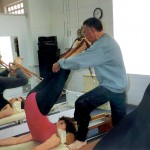Embodying the Brilliance of our BioIntelligent Wisdom
By Wendy LeBlanc-Arbuckle
As we transition into 2017, I’d love to build on the wonderful article that Kathy Corey recently wrote for Pilates Intel on “The Importance of Honoring our Heritage”.
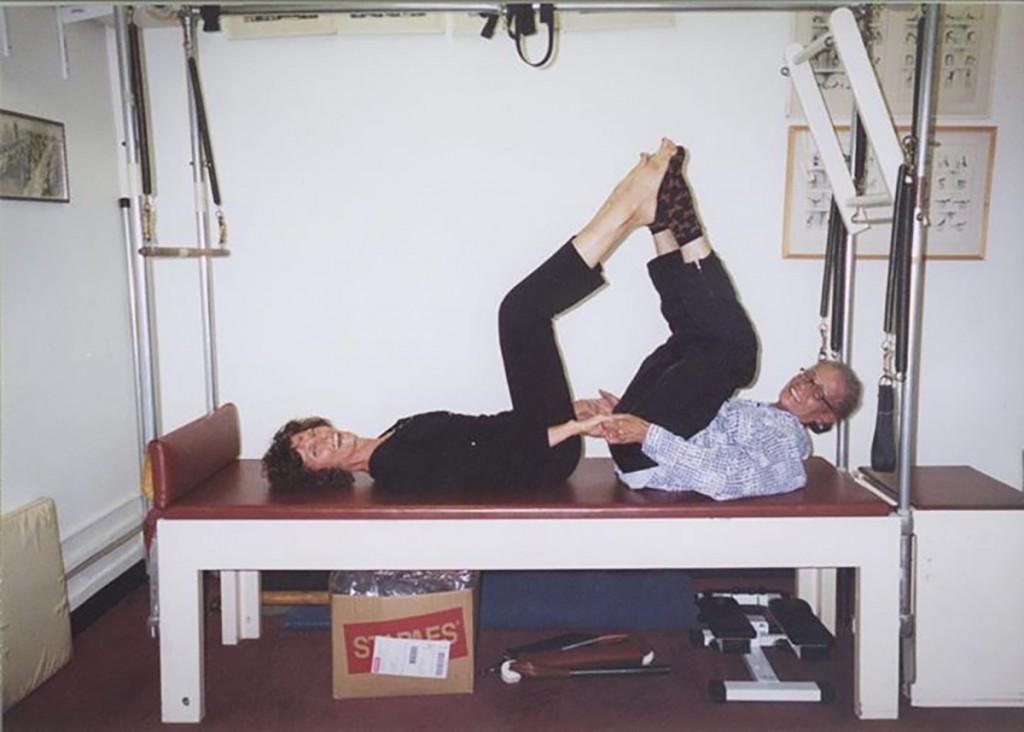 I couldn’t agree more! Kathy begins her article with the quote “Heritage is the linking of the present to its original source.” It is essential that we never lose our connection to the source of our work, and that we always seek to honor and build on our heritage. I am also committed to continually deepening the font from which we source the work we do, in whatever form and place that may be. What this means is our willingness to continue to inquire, to remain open, to resist the pull toward planting an immovable stake on holy ground … in other words, it’s not “wrong” to inquire into the work we have been taught, it’s healthy! Are we willing to refresh our perspectives based on new understandings of how our bodies function … awarenesses that were not fully appreciated in Joseph Pilates’ lifetime?
I couldn’t agree more! Kathy begins her article with the quote “Heritage is the linking of the present to its original source.” It is essential that we never lose our connection to the source of our work, and that we always seek to honor and build on our heritage. I am also committed to continually deepening the font from which we source the work we do, in whatever form and place that may be. What this means is our willingness to continue to inquire, to remain open, to resist the pull toward planting an immovable stake on holy ground … in other words, it’s not “wrong” to inquire into the work we have been taught, it’s healthy! Are we willing to refresh our perspectives based on new understandings of how our bodies function … awarenesses that were not fully appreciated in Joseph Pilates’ lifetime?
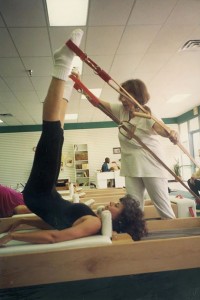 As a somatic yoga, Pilates and Structural Integration Practitioner in the Pilates community (studying first with Romana Kryzanowska and then with Kathy Grant, Ron Fletcher, Mary Bowen and Lolita San Miguel), I have the great good fortune of developing an expanded perspective of Joseph Pilates’ vision of “whole body health”.
As a somatic yoga, Pilates and Structural Integration Practitioner in the Pilates community (studying first with Romana Kryzanowska and then with Kathy Grant, Ron Fletcher, Mary Bowen and Lolita San Miguel), I have the great good fortune of developing an expanded perspective of Joseph Pilates’ vision of “whole body health”.
What I have come to see, in studying with these Pilates Elders is that they each have their own interpretation of what they were taught … and that each of them embodied Joseph Pilates’ teachings in a way that honored his legacy, as they fueled their own passion for teaching. I believe that we can each continue to honor his legacy, while discovering our own voice and contribution to this great work, without coming from a right/wrong perspective.
With this in mind, consider that, in Joseph Pilates lifetime, a “biomechanical” perspective, based on cadaver dissections and a “pieces and parts” understanding of our bodies as machines to be trained and fixed was most accepted. In this perspective, muscles are defined as “weak or strong” … so we strive to “make our bodies stronger” by exercising or stretching that area more.
Much of the same thinking still pervades the way we teach movement education today, in the face of an overwhelming body of discovery that dramatically points otherwise.
A paradigm that fosters a strict adherence to a “biomechanical” perspective separates us from our own “biointelligent human heritage” … our embryological beginnings. It is here, as an embryo, where we develop through spiraling fluid fields that shape our spines, organs, brains, limbs, and all the systems that move and nourish us throughout life. And this is so incredible … because the embryological spiral forces that formed our body in the womb are continuously at work (as our self-healing, self-organizing, internal reference point known as proprioception) throughout life, carrying the blueprint of health into manifestation at every moment of our lives.
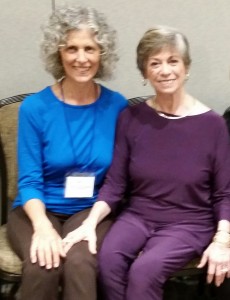 In other words, through this innate potency, we are being guided by the wisdom of our biointelligence, supported by the logic of nature from birth to death! The question is, are we listening to, and learning from this vital relationship with our bodies … or controlling them?
In other words, through this innate potency, we are being guided by the wisdom of our biointelligence, supported by the logic of nature from birth to death! The question is, are we listening to, and learning from this vital relationship with our bodies … or controlling them?
“When we try to pick out anything by itself, we find it hitched to everything else in the universe” – John Muir, naturalist
As we consider this quote, we realize that the Abdominals or the Psoas are never the most important muscles in the body. The body doesn’t have a favorite muscle. And neither did Joseph Pilates, as he told Mary Bowen when she studied with him and was exploring movement – “Just remember to use your whole body in every exercise.”
So, while honoring the genius of our heritage, we can continue to update our awareness of how our bodies function in relationship with gravity and spatial orientation … which will bring forth new ways of languaging and cueing that move us from a “biomechanical” perspective with the “teacher as expert to fix the client”… to an embodied “biointelligent “approach where the “client becomes an expert” in learning about their own body, and how to be self-healing.
In this way, we see that an updated awareness of “core” is based on relationship of the whole body to itself, others, gravity and the environment, rather than a focus on the abdominals. When we “sense” this embodied way of moving in Pilates, our hands, arms, feet and legs and head connect fluidly THROUGH our pelvic and shoulder girdles to our “breathing spines”. We become more aware of the grounding, centering and spatial forces in our environment that we are constantly interacting with and “touch” becomes about a relational, whole body way of being with the Pilates apparatus, or any prop or person we are interacting with at the time.
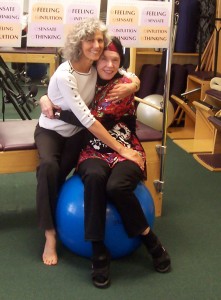 We’ve taken off the “pressure” of having to be an expert … and are “present” and guided by the body’s wisdom at that moment. This creates workouts and teaching sessions where everything is a learning moment, even with the Pilates repertoire that we already “know” … in this way, one becomes deeply nourished, and fascinated by what each person’s body wisdom has to teach.
We’ve taken off the “pressure” of having to be an expert … and are “present” and guided by the body’s wisdom at that moment. This creates workouts and teaching sessions where everything is a learning moment, even with the Pilates repertoire that we already “know” … in this way, one becomes deeply nourished, and fascinated by what each person’s body wisdom has to teach.
This biointelligent approach to Pilates, steeped in a relational way of being in the world, which has grown me over the years, has opened me to a deeper understanding of the potential power of embodied movement in Pilates and other mind/body disciplines. How can we achieve Joseph Pilates’ vision for “World Peace” if we only celebrate what is “Pilates Perfect” … like doing the “perfect” Teaser? It’s the process of learning the Teaser, and of slowing down to re-evaluate our old movement patterns when we are injured, that creates the “human being” in us … being generous, loving and kind to ourselves so we can hold that space for someone else … and plant those seeds in the world and have them grow!
** To discover and explore more about biointelligence and embodied Pilates, please join me as I co-teach two life changing “collaborative” workshops with Trent McEntire and his Arcus Bar Level 1 and 2 (Austin, Texas, March 3rd and 4th) and with Mary Bowen (Asheville, North Carolina, April 8th and 9th) . For more information, please visit: www.pilatescenterofaustin.com or e-mail info@pilatescenterofaustin.com
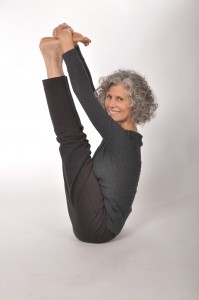 Wendy is an International leader in embodied movement education, with a 40 year background in holistic health, and lifelong studies and collaborations with distinguished pioneers in yoga, Pilates, Structural Integration bodywork, somatic arts and sciences, dynamic breathwork and energy medicine.
Wendy is an International leader in embodied movement education, with a 40 year background in holistic health, and lifelong studies and collaborations with distinguished pioneers in yoga, Pilates, Structural Integration bodywork, somatic arts and sciences, dynamic breathwork and energy medicine.
Wendy studied with 5 of the Pilates Elders who studied directly with Joseph Pilates, and has been inspired by the diversity of their teaching expressions. Additionally, her extensive yoga background, along with studies with Bonnie Bainbridge Cohen, Emilie Conrad, Susan Harper, Judith Aston, Tom Myers, The Guild for Structural Integration, Hubert Godard, Phillip Beach and Jaap van der Wal, with profound breath, fascial and ontological studies, helped Wendy develop her own “biointelligent” voice. Her vision has been to illuminate the universal core principles that underlie all great bodymind practices, enabling students and practitioners of any discipline to discover their wholeness through cultivating their own voice, through the portal and brilliant guidance of their biointelligent wisdom.
A founding member of the Pilates Method Alliance. the Fascia Research Society and International Association of Structural Integrators, she is a PMA-CPT, a presenter for Pilates Anytime and FusionPilatesEDU , and honored to be a Second Generation Mentor in Balanced Body’s Passing the Torch Mentoring Program.
Website: www.pilatescenterofaustin.com

